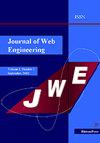Adversarial Attacks on Pre-Trained Deep Learning Models for Encrypted Traffic Analysis
IF 1
4区 计算机科学
Q4 COMPUTER SCIENCE, SOFTWARE ENGINEERING
引用次数: 0
Abstract
For web security, it's essential to accurately classify traffic across various web applications to detect malicious activities lurking within network traffic. However, the encryption protocols for privacy protection, such as TLS 1.3 and IPSec, make it difficult to apply traditional traffic classification methods like deep packet inspection (DPI). Recently, the advent of deep learning has significantly advanced the field of encrypted traffic analysis (ETA), outperforming traditional traffic analysis approaches. Notably, pre-trained deep learning based ETA models have demonstrated superior analytical capabilities. However, the security aspects of these deep learning models are often overlooked during the design and development process. In this paper, we conducted adversarial attacks to evaluate the security of pre-trained ETA models. We targeted ET-BERT, a state-of-the-art model demonstrating superior performance, to generate adversarial traffic examples. To carry out the adversarial example generation, we drew inspiration from adversarial attacks on discrete data, such as natural language, defining fluency from a network traffic perspective and proposing a new attack algorithm that can preserve this fluency. Finally, in our experiments, we showed our target model is vulnerable to the proposed adversarial attacks.对用于加密流量分析的预训练深度学习模型的对抗性攻击
对于网络安全而言,必须对各种网络应用程序的流量进行准确分类,以检测网络流量中潜伏的恶意活动。然而,用于隐私保护的加密协议(如 TLS 1.3 和 IPSec)使得深度数据包检测(DPI)等传统流量分类方法难以应用。最近,深度学习的出现极大地推动了加密流量分析(ETA)领域的发展,其性能优于传统的流量分析方法。值得注意的是,基于预训练深度学习的 ETA 模型已显示出卓越的分析能力。然而,在设计和开发过程中,这些深度学习模型的安全方面往往被忽视。在本文中,我们进行了对抗性攻击,以评估预训练 ETA 模型的安全性。我们以 ET-BERT 为目标,生成对抗性流量示例,ET-BERT 是一款性能卓越的先进模型。为了生成对抗示例,我们从自然语言等离散数据的对抗攻击中汲取灵感,从网络流量的角度定义了流畅性,并提出了一种可以保持这种流畅性的新攻击算法。最后,在实验中,我们证明了我们的目标模型很容易受到所提出的对抗性攻击。
本文章由计算机程序翻译,如有差异,请以英文原文为准。
求助全文
约1分钟内获得全文
求助全文
来源期刊

Journal of Web Engineering
工程技术-计算机:理论方法
CiteScore
1.80
自引率
12.50%
发文量
62
审稿时长
9 months
期刊介绍:
The World Wide Web and its associated technologies have become a major implementation and delivery platform for a large variety of applications, ranging from simple institutional information Web sites to sophisticated supply-chain management systems, financial applications, e-government, distance learning, and entertainment, among others. Such applications, in addition to their intrinsic functionality, also exhibit the more complex behavior of distributed applications.
 求助内容:
求助内容: 应助结果提醒方式:
应助结果提醒方式:


